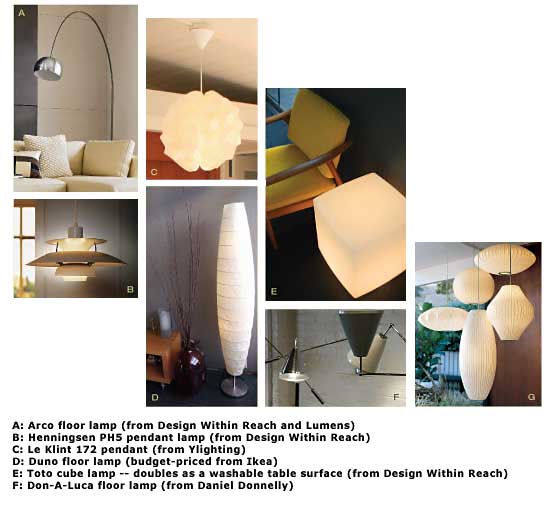Modern Lighting - Page 3
Lighting uses 12 to 15 percent of the electricity consumed in a home, according to the American Lighting Association. You can save energy—and money—by turning off lights when you don't need them, using dimmers to save energy, and switching to more efficient bulbs, such as fluorescents, wherever possible.
California has some special codes called 'Title 24' that, among other things, mandate the need for efficient lighting. As of January 2006, code inspections required that at least 50 percent of the fixtures in remodeled or new kitchens must be florescent fixtures (not just bulbs—an important distinction).
Florescent lighting of five years ago is much different than today's models, according to contractor Scot Nicholls. Electronic ballasts turn the light on as fast as any incandescent bulb, and colors (including one's pallor) will look better when under these lights than ever before. The downside? Fluorescent fixtures are still not as directed in their tasks and tend to be fairly ambient, washing out shadows and drama.
Another 'green' Title 24 mandate brings a new technology into play for switching, which sometimes includes occupancy sensors. This replaces the light switch with a slightly different kind of switch that needs to be turned on manually as you enter a room. If this switch doesn't detect continued activity in the room after five minutes, it shuts the light switch off automatically.
"If you are quietly working at a desk, you need to jump up every four minutes or so and flail around to reset the timer to the light bulb," Nicholls explains.
Updated versions of these fixtures offer 'shoes' that electronically convert the regular line voltage of the track into a low voltage that allows for the use of a bulb called an MR-16. This bulb, used by merchandisers and museum curators, is a 12-volt halogen light. At 50 watts it gives off a light that very closely represents daylight. "Meat looks redder, vegetables greener," says Nicholls. "It is controlled and full spectrum. And it is also small and minimal."
Low-voltage lighting consists of a plug-in transformer, low-voltage cable and low-voltage light fixtures. The transformer plugs into a grounded outdoor power receptacle and reduces 110-volt current (standard) to a 'safe' 12 volts (low voltage). The cable attaches to the transformer and distributes power to the light fixtures connected along the length of the cable.
Cable and monorail fixtures are the contemporary evolution of the track fixture. These low-voltage options can be useful in modern homes because routing their wires is a little easier. Two cables strung across a ceiling can each have a 12-volt potential between them; yet, when one's hand touches the bare cables, the current is not sensed. Because of their proprietary designs, it's usually best to use monorails and coordinating fixtures that originate from the same manufacturer. Cable fixtures, on the other hand, are more generic and can be combined with fixtures from differing manufacturers.
Low-voltage lighting makes for clean, minimal, and modern design. Fixture styles range from brilliant brushed metal surfaces to elegant glass diffusers.
"Depending on the product and the finish, low-voltage lighting can also make the lighting system disappear, for a true minimalist affect," says Thomas Erik Nielsen of Translite Sonoma. Rubbed-bronze cable, for example, disappears against a dark background.
Of course, a black track system in an all-white interior would make for a stunning contrast if it works with the rest of the decor.
Pendant lights combine functionality and art. They can be used as task lighting above a counter or an island and provide lighting for a smaller dining table. Designer Poul Henningsen spent a good part of his adult life perfecting the non-glare pendant fixture and, according to Nicholls, his best fixture is the PH-5, circa 1950.
Other stylish pendant fixtures include those from Jacobsen, Nelson, and Eames. Popular task and accent lights for modern homes include the saucer, pendant, and cigar styles of lights.
No matter which modern fixtures one chooses for the home, it's almost always best to put each on a dimmer. Dimmers allow those in the home to become masters of the domain. Need a romantic mood for an elegant dinner? Dim the lights. Working on a project on the kitchen table? Turn up the lights. An electrician can help pair the ideal dimmers for each fixture.

Photos: Rochelle Kramer, Michael Greene; also courtesy Alison and Danny Benaderet, Linda Beattie, Translite Sonoma, Design Within Reach, and Daniel Donnelly
Special thanks to Scot Nicholls and Lumens Light + Living for their assistance with information and product direction




